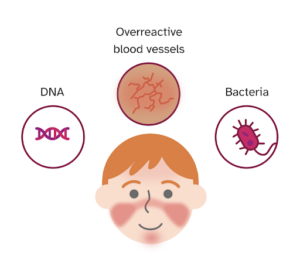This week, we released a new report Powered by 23andMe Research on Rosacea for 23andMe+ members.
Rosacea is a chronic skin condition that typically affects the central parts of the face.
It is commonly characterized by flushing, redness, and visible blood vessels, but symptoms can vary; some individuals experience irritation or inflammation of the eyes or eyelids, while others experience thickened skin on the nose.
Symptoms may also come and go in response to environmental triggers.
Understanding Rosacea
It is estimated that around 5 percent of adults have rosacea.
It is more prevalent among older adults, females, and individuals with family histories of the condition.
The exact cause is not well understood. Evidence suggests that genetics and inflammation caused by an overactive immune system may play a role. Other factors may also contribute to risk, including overreactive blood vessels that dilate too easily, sensitivity to microorganisms that naturally live on the skin, and an imbalance of natural bacteria that live in the gut.
Research on rosacea
Current research aims to understand rosacea and identify therapies that can help.
In 2015, scientists from 23andMe and Stanford University School of Medicine identified two genetic variants strongly associated with rosacea among people of European ancestry.
One of these markers can be found near genes involved with other conditions, such as diabetes and celiac disease. Another sits between BTNL2 and HLA-DRA, genes associated with histocompatibility and immune response.
Later research from 23andMe and GlaxoSmithKline also unearthed seven gene regions associated with rosacea symptom severity.
A new report
Our new report is powered by data from consented 23andMe research participants and uses machine-learning techniques to estimate an individual’s likelihood of developing rosacea.
This estimate uses a statistical model that includes 14,154 genetic markers and information on an individual’s ethnicity and birth sex.
Managing rosacea
There is no cure for rosacea, but individuals can manage it by identifying and avoiding triggers, like sunlight and emotional stress, and by working with a healthcare professional to consider other treatments like medications and light-based therapies.
Simple lifestyle changes can also help. For people with rosacea, it is especially important to protect the face from UV light, use gentle skin cleansers, and moisturize regularly. Counseling and support groups can also help with feelings of embarrassment or depression that can arise from the condition.
Learn more
23andMe’s new Rosacea report (Powered by 23andMe Research) is available to all annual members of the 23andMe+ Membership. To view your report, go here.
Not an annual subscriber to the 23andMe+ Membership?
Find out more here.




